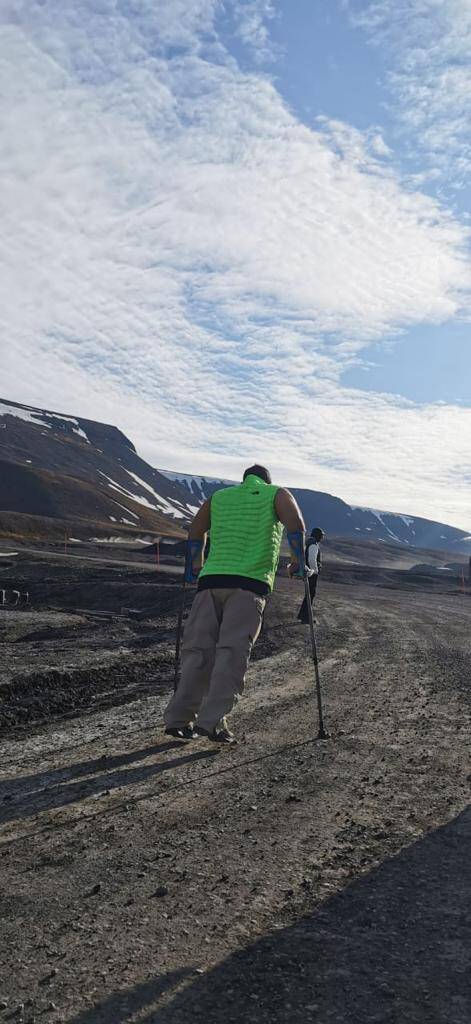Michael Haddad – Walking for life

Walking for life
Earlier this year, Lebanese endurance athlete Michael Haddad embarked on a series of ‘Walks for Life’ in North Africa and Norway to raise global visibility of the impacts of climate change on rural farmers in the region and beyond. Michael carried symbolic ‘packets of hope’ that contained climate-vulnerable but vital seeds of wheat, barley, lentil, chickpea, and forage crops (as well as a limited edition of a book he had personally collected from Pope Francis) to deposit safely into the Svalbard Vault.
On International Day of Disability, we talk to Michael about his life experiences and what his Walks for Life meant to him.
- When you were six years old, a jet-ski accident left you paralyzed from the chest down. Why did you decide to become an athlete and pursue these challenging walks?
It was a complicated process over time. After the accident, I was full of anger. I could not understand why this terrible incident had happened to me, a child. But gradually, through pain and reflection, a transformation took place that led me to a choice: I could either keep hating myself and everyone around me and remain stuck in a spiral of pain or try to find a way to live my life positively. Through determination and spiritual contemplation, I broke down the psychological barriers and transformed myself from a ‘disabled person’ to a differently abled person.
- You just finished a five-kilometer walk on the ice-capped island of Svalbard. How do you do it?
The fact I can walk is not just a result of my mental grit – even though that sustains me every day. Firstly, scientists from the Lebanese American University and the American University in Beirut partnered to design a made-to-measure exoskeleton that holds me upright and allows me to walk. It’s a symbiotic relationship! On these walks, I push exoskeleton technologies to the max, allowing scientists to improve the technology while making it more affordable. In fact, I am a valuable research project! Upper body muscles should not carry the whole body, especially on extreme walks. That perseverance is only possible through brain power. My scientist partners believe that my perseverance and brain composition is like that of a professional athlete as I can take my brain to a different dimension. By pushing myself to the extreme, scientists can learn from me, and in turn, I can enhance the lives of other people in similar conditions.

- Can you tell us more about the exoskeleton?
If you are paralyzed from the chest down, there is no muscle structure to hold you together because the electrical circuits from the brain to the body parts are cut or confused. You constantly feel the weight of a truck crushing your body. With the exoskeleton, I can stand upright and lift my body one step at a time. I use a ‘swing-to-gait’ walking method, like an inverted pendulum, and I harness that energy to move. Right now, there is not much available for paralyzed people except bulky and expensive robotic machines, and there is little advanced research taking place on spinal cord injuries. As I gained dexterity and confidence in walking, I wanted to use my knowledge and experience to help other paralyzed people achieve their dream of standing up and walking.
- How do you compare your physical and mental feats to the climate crisis?
From a practical perspective, the Earth is now sitting in a wheelchair, and climate change is a disability harming all of us. Climate change amplifies conflicts and food insecurity and does not affect everyone equally. The most vulnerable, like poor rural farmers, are on the frontline of the worst impacts. People with disabilities emphasize with that vulnerable category. It is time to make our voices heard.
- What are the packets of hope you carried on your Walks of Life?
My journey began in the Bekaa Valley of Lebanon and took me far North to the Svalbard Archipelago in Norway. I proudly carried seed pouches with 12 different crop varieties from my region, where wheat originated. This journey is highly symbolic, signifying why we must stand together to address climate change, protect vulnerable agrobiodiversity, and harness our collective knowledge to halt food insecurity. We cannot overstate the severity of the current situation.

- What challenges did you face in Svalbard?
Even small actions are hard work when you’re strapped in an exoskeleton and carrying a heavy kit. I exert 30 times more effort than a non-disabled person. So the walk in those conditions was challenging and exhausting. It took me over six hours to cover five kilometers. I lifted my entire body using my upper body strength over 10,000 times. The last 2 kilometers were uphill and by far the most physically and mentally difficult. But the feeling I had when I finished and how everyone reacted made it all worth it.
- What comes next?
I am now preparing for a 100-kilometer Artic walk to raise awareness on food security issues. The former president of the Lebanese American University, Joseph Jabra, summarized how I feel about the challenge by saying that a person like Michael Haddad walking 100 kilometers across the North Pole is as technologically demanding as putting a person on the moon. But given the grave danger we are all in because of climate change, I must do my bit.
